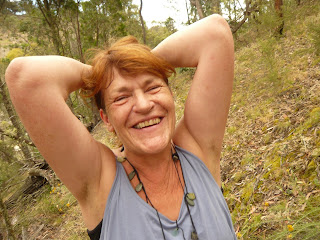The route I took comes to just about 135km. I deviated from the marked CCT on a number of occasions, either deliberately to climb adjacent hills, or inadvertently due to poor signage or inattention, or both. This map shows my entire route, as recorded in Orux tracklogs imported to Google Maps.
I set out with the intention of completing the walk in a week. It ended up taking 15 days, although I only walked the CCT on seven of them. What interrupted the walk were a couple of days I had medical appointments, a day I had the car booked in for a service (and went for a bike ride around the lake), a couple of regular bushwalks, and a couple of rest days. All told, it took some 38.5 hours of walking, including stops.
The walking turned out to be more challenging than I'd anticipated, but I attribute that at least in part to the numerous detours I took to climb hills. On the days I piked after a short distance, my feet were so sore that it really would have been an unpleasant slog to have proceeded any further. I don't know if I have the wrong boots, or the wrong feet, or am just too much of a wooss.
The logistics of walking the CCT alone are formidable. It is apparently possible to do it using public transport, although I don't think there is an Action bus service to Hall. In any case, that can add up to 90 minutes of extra travel at each end of the day, apart from some additional walking. Walking with others and doing a car shuffle can also be time consuming. The reason I could do it the way I did, stopping whenever I pleased, was that my friend Jo agreed to get up and drive me to my starting point and pick me up wherever I got to. I doubt I'd have ever considered undertaking it without the prospect of her support.
 |
| Jo |
Much of the trail is exposed, and it's probably more exposed than I think because most of my deviations took me through woodier areas with some shade. The bad news is you can get quite a sunburn. The good news is you get almost uninterrupted panoramas of the Brindabella and Tidbinbilla Ranges, along with nearer hills and landmarks, when the weather is clear, as it often is.
A large proportion of the CCT follows 'dual use' cyclepaths. These are not my preferred surface for walking as they can be quite boring. When forced to follow one, I walk on the verge alongside it as much as surrounding shrubbery permits, especially when wearing earphones, and definitely if I stop for any reason. Oblivious pedestrians can be a real hazard on the cyclepaths.
The signage along the CCT is sometimes quite adequate, with readily visible and unambiguous markers at every junction. Elsewhere it can be confusing. My preference for a trail like this would be to ensure that every intersection was unambiguously marked, especially around road crossings, with reassuring markers periodically along the way. It would be way better if each sign, or at least every once in a while, indicated the direction it was heading. They could show the name of the next roadhead, and even the remaining distance, or at least indicate whether you were going clockwise or anticlockwise.
As others have remarked, the trail is a bit of a compromise because of the desire to make it negotiable by mountain bike, which means avoiding some rougher sections and pretty well every hill. As a matter of fact, it might be possible to do on a road bike, although there are some loose sections. It would be good if there were marked pedestrian detours to take in the hills, while avoiding fences! There are other aspects of the route that struck me as inexplicable, as mentioned as we go along.
Because I had walked sections of the trail before, and because David Briese took so many, in good conditions, that I liked, I didn't take many photos. Most of the images in this account are the photo waypoints I recorded in Orux Maps. There are some other images here.
This map shows the official route.






















